|
 Amanita nothofagi Amanita nothofagi
SynonymsAmanita excelsa
BiostatusPresent in region - Indigenous. Endemic
Images (click to enlarge)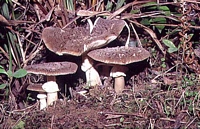
Caption: Amanita nothofagi | 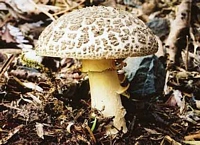
Caption: Amanita nothofagi | 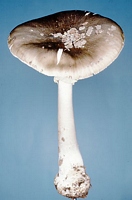
Caption: Amanita nothofagi | 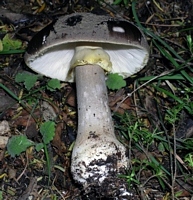
Owner: J.A. Cooper | 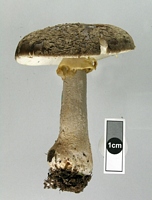
Owner: J.A. Cooper | 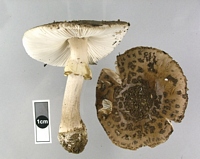
Owner: J.A. Cooper | 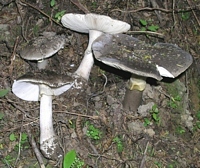
Owner: J.A. Cooper | 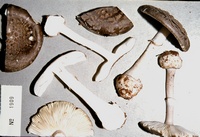
Caption: ZT1909
Owner: E. Horak: © Creative Commons Attribution-Noncommercial 3.0 New Zealand | 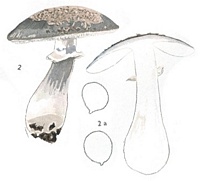
Caption: Plate 2, A. nothofagi, x 1 ;2a, spores, x 2000
Owner: PDD | 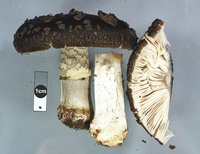
Owner: J.A. Cooper |
Article: Ridley, G.S. (1991). The New Zealand species of Amanita (Fungi: Agaricales). Australian Systematic Botany 4(2): 325-354.
Description: Basidiocarps small to large, solitary to subgregarious. Pileus 30-130 mm, convex to plano-convex, then plano-depressed, with striate margin (0.05-0.06 R), entire, colour variable, buff to pale buff, dark mouse-grey to greyish sepia, hazel or cinnamon to buff, dark greyish sepia radially streaked with fuscous, or fuscous black streaked with greyish sepia, viscid when young or wet, drying with age, volva remnants forming small to extensive, irregularly shaped, felted patches, dull greyish sepia to sepia, occasionally scab-like, then greyish sepia with pale centres, rarely arranged concentrically. Lamellae crowded, free, white to 'cream', margin entire, 6- 10 mm wide, lamellulae subtruncate. Stipe 40-140 mm high, 5-25 mm diameter, tapering slightly at apex, hollow, from sub-bulbous, or occasion- ally abruptly bulbous base, 10-30 mm diameter, surface above annulus white, sparsely floccose, occasionally breaking into transverse bands, below annulus smooth or occasionally breaking into bands or fibrillose scales, white, sordid white, buff or greyish sepia streaked with mouse-grey, base with or without a band or rim of buff to greyish sepia volva remnants. Annulus membranous, striate, white, sordid white, buff, greyish sepia or lavender-grey, pendulous then adhering to stipe, often tearing and adhering to pileus edge. Context of pileus white or stained mouse-grey under the disc, occasionally with a grey line above lamellae, stipe white to pale buff.
Spore print white. Basidiospores (929/78), (6.5-)7.5-9(-13) x (6.5-)7.5-9(-13) µm, Qm 1.05, Q 1.00-1.16(-1.40), globose to broadly ellipsoid, occasionally ellipsoid, thin- walled, hyaline, amyloid. Basidia 30.5-57 x (6.5-)8-16 µm, 4-spored, rarely less, not clamped. Lamella margin cells numerous, 13-58 X 8-33 µm, globose, clavate or sphaeropedunculate, hyaline. Pileipellis consisting of 130-220 µm wide, strongly gelatinised suprapellis and dense, non-gelatinised subpellis. Volva remnants on pileus consisting of abundant globose, elliptic and clavate cells, 21-119 x 14.5-115 µm, intermixed with 4-9 µm wide hyphae, pale umber and either irregularly arranged, or tending to vertically orientated.
Article: Stevenson, G. (1962). The Agaricales of New Zealand: II. Kew Bulletin 16(1): 65–74.
Description: Pileus 7 cm. diam., charcoal grey with patches of soft brownish scales, flesh white but stained grey under the cuticle. Gills free, white developing a faint yellow tinge, moderately crowded. Stem 1.5 x 7 cm. tapered upwards, solid, white above ample ring, dark-grey below. Volva whitish, concrescent over bulbous base. Spores amyloid, globose, 7-8um diam.
Habitat: under Nothofagus solandri, Nelson 18.4.1954 & I I .5.1957, Stevenson; under Leptospermum etc., Cape Farewell, 29.3.1957, E. Kidson.
|